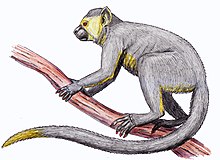Eosimiidae
| Eosimiidae Ma Early Oligocene[1]
| |
|---|---|

| |
| Life restoration of Eosimias sinensis
| |
| Scientific classification | |
| Domain: | Eukaryota |
| Kingdom: | Animalia |
| Phylum: | Chordata |
| Class: | Mammalia |
| Order: | Primates |
| Suborder: | Haplorhini |
| Infraorder: | Simiiformes |
| Family: | †Eosimiidae Beard et al., 1994 |
| Genera | |
| |
Eosimiidae is the possible family of extinct primates believed to be the earliest simians.
Taxonomy
When they were discovered, the possibility that Eosimians were outside and ancestral to Simians was considered (Culotta 1992), but subsequent work showed them to be Simians (Kay et al. 1997, Ross et al. 1998).[3] Some scholars continue to question whether the eosimiids are simians, as they seem closer to Tarsiiformes - Gunnell and Miller (2001), for instance, found that eosimiid morphology didn't match up to anthropoid (simian) morphology.[4] However, most experts now place Eosimians as stem simians - Williams, Kay and Kirk (2010) note this is because more and more evidence points in that direction.[5]
Williams, Kay and Kirk note that (as at late 2009), accounting for all proposed species, there would be 11 species in total in 6 genera (
There appears to be a wealthy diversity of eosimiids in China.With several genera, such as Phileosimias, and
Phylogeny
Below is a phylogenic tree with some of the extinct simian species with the more modern species emerging within the Eosimiidae. Anthrasimias is not shown. The Simians originated in Asia while the crown simians were in Afro-Arabia.[7][8][4][9][10] It is indicated approximately how many million years ago (Mya) the clades diverged into newer clades. In this tree, Eosimiidae as conventionally defined, shown as italic, is a paraphyletic, 'grade' or stem group in this assessment. Paraphyletic groupings are problematic, as one can not talk precisely about their phylogenic relationships, their characteristic traits and literal extinction.[11][12] Cladistically the 'higher' monkeys are included. The Ekgmowechashaladea are usually placed in Tarsiiformes, in which case Eosimiidae may become equivalent to the Simians. Alternatively, with Phileosimias and Amphipithecidae placed outside of an Eosimiidae sensu stricto taxon would restore monophyly.
| Haplorhini (64) |
| |||||||||||||||||||||||||||||||||||||||||||||||||||||||||||||||||||||||||||
See also
- Evolutionary biology
- Afrasia
References
- ^ "Eosimiidae". paleobiodb.org. Retrieved 2021-07-28.
- ^ Haaramo, Mikko (2002-12-29). "Mikko's Phylogeny Archive". Retrieved 2007-07-05.
- ISBN 978-1461347002.
- ^ a b Primate Adaptation and Evolution: 3rd Edition, Ch. 13, p 279-281
- ^ PMID 20212104.
- PMID 15937103. (Full text PDF)
- PMID 15937103.
- S2CID 89631627.
- PMID 22696520.
- ISBN 978-0-19-539043-8.
- ISBN 9789400723351.
- PMID 29380889.
External links
- Beard KC, Wang J (Apr 2004). "The eosimiid primates (Anthropoidea) of the Heti Formation, Yuanqu Basin, Shanxi and Henan Provinces, People's Republic of China". J Hum Evol. 46 (4): 401–32. PMID 15066378.
- Kay RF, Ross C, Williams BA (Feb 1997). "Anthropoid origins". Science. 275 (5301): 797–804. S2CID 220087294.
